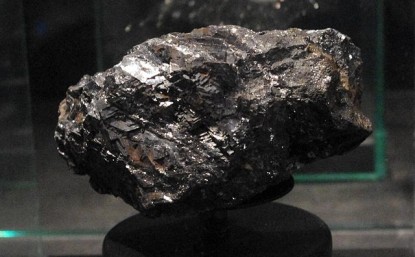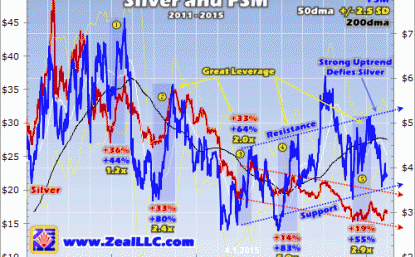
The Spaniards of centuries past controlled the world’s elite maritime fleet. And this fleet’s colonization of the Americas is well-documented. The Spanish Crown would have told you their primary mission was to convert the indigenous people to Catholicism. But in reality it was trade and a craving for all things exotic that ultimately supported this campaign.
And perhaps the one thing that the Spaniards couldn’t get enough of was silver. In Mexico and Peru in particular they found hoards of this shiny-white metal. And via both conquest and discovery they quickly gained control of the world’s silver trade.
Though Spain no longer controls the trade today, Mexico and Peru are still atop the silver rankings, collectively responsible for about one-third of the world’s mine production. And this allows for fortunes to be made by the mining companies on the ground in these two countries. In Spanish the word fortune is translated as fortuna. And Fortuna Silver Mines is poised to live up to its name as one of Latin America’s premier primary silver producers.
Fortuna was founded in 2005 by CEO Jorge Ganoza. Ganoza is a geological engineer by training, but more importantly he’s a fourth-generation Peruvian mine-builder. With this kind of pedigree, not many people understand Peru’s geology better. So naturally Ganoza’s first major play was in his home country.
With silver prices on the rise Ganoza and team sought an advanced-stage project that could quickly be brought into production. And what better project than one of Peru’s finest historic silver mines, the Caylloma mine located high in the Andes Mountains of southern Peru.
Caylloma’s namesake district had seen mining since the times of the Inca Empire over 500 years ago. And most of the 250m+ ounces mined there have come from the formal Caylloma mine. This underground operation pulled from a rich intermediate-sulfidation epithermal deposit, and had made a lot of money for its owners over the years. But when Fortuna took over it had recently been placed on care-and-maintenance, essentially left for dead.
Ganoza and team’s due diligence obviously saw great potential in reviving Caylloma. And a big factor would be Fortuna’s unbiased approach to its polymetallic veins. Previous owner Hochschild Mining was really only interested in Caylloma’s silver-rich veins, and thus ignored the veins that had higher concentrations of gold and base metals in addition to silver.
Fortuna was all too happy to accept what Caylloma had to offer though. Not only did it see potential in continuing to mine and grow the resources in the silver-rich area, it would develop the other polymetallic veins deemed to have positive economics.
Fortuna’s mine-revival plan included drilling in the highest-prospective areas to prove up resources, as well as mill upgrades and enhancements. And in less than a year it was able to resume production. Fortuna has since transformed Caylloma into a long-life low-cost mine that has produced over 13m ounces of silver since 2007.
And this mine will be producing for many more years to come with a silver resource base that includes 36m ounces per the latest estimate (including 13m ounces of 2P reserves). Caylloma is currently producing at a consistent rate of just over 2m ounces per year. And with strong byproducts of zinc, lead, and gold, its all-in sustaining costs are under $13/ounce.
For its Caylloma encore, Fortuna Silver Mines ventured up north into Mexico. And its expert exploration team found a fascinating project in the historic Taviche mining district in central Oaxaca. The San Jose project had seen intermittent small-scale mining since the mid-1800s. And what piqued Fortuna’s interest was not only the past mining success, but positive exploration results from a junior miner that was already on the scene.
This junior had outlined a small high-grade resource. But more importantly, exploration showed that only a small portion of San Jose’s low-sulfidation epithermal vein system had been exploited. Fortuna ended up acquiring said junior, and it proceeded to aggressively drill its exciting new silver/gold deposit. The assays delivered one bonanza-grade intersect after another, and within a few years Fortuna completed a prefeasibility study that showed the potential for smashing economics.
With a price tag of only $55m, Fortuna needed no more convincing to move forward with mine development. And in 2011 San Jose poured its first silver following a methodical on-time on-budget build. Mining occurs from the underground via ramp access. And following a 2013 expansion that doubled capacity at the flotation mill (2.0k tonnes per day), production now yields about 4.3m ounces of silver and 33k ounces of gold annually.
This expansion was supported by a very strong resource base. And thanks to another recent jolt to this project’s inventory, Fortuna already has its sights on another expansion. This latest expansion will increase mill capacity by 50%, and it’ll be fed by the exciting Trinidad North zone.
Fortuna made the recent Trinidad North discovery down-dip and to the north of San Jose’s main Trinidad zone. TN’s system of veins, stockworks, and hydrothermal breccias were found to be very wide and of much higher grade than the rest of the deposit. And after extensive drilling TN added 50m ounces of silver and 320k ounces of gold, bringing San Jose’s total to 90m/644k ounces respectively.
The expansion to 3.0k tpd is expected to cost approximately $30m. And Fortuna is targeting mid-2016 for its completion. Once at full capacity San Jose will produce in the neighborhood of 7.5m ounces of silver and 54k ounces of gold per year, making it one of Mexico’s largest primary silver mines.
San Jose is also a low-cost producer that ought to thrive even in this lower-silver-price environment. Its cash operating costs are typically among the lowest in the industry at under $4/ounce after the gold credit. And although its 2015 all-in sustaining costs will be on the high side at $16/ounce, greatly inflated by a $6/ounce non-recurring capital investment to build a dry-stack tailings disposal facility, in general they’ll be in the lower quartile of industry average (sub-$9/ounce projected after the expansion).
Overall Fortuna’s spectacular Peruvian and Mexican assets make this company quite attractive to investors. And they also fancy its financial standing, with one of the strongest balance sheets in its peer group. As of its latest filing, Fortuna had no debt and a working-capital position of $82m (including $77m in cash). And with this capital, sustainable free-cash-flow generation, and a $60m credit facility, it’ll easily be able to self-fund the dry-stack tailings and expansion projects.
Given Fortuna’s all-around fundamental and financial strength, investors should be confident that its stock will be among the sector’s best performers when silver runs higher. Even over the last few years as FSM has suffered with its sector, it didn’t let investors forget what it was capable of when the metal rallied.

This chart looks very similar to most precious-metals mining stocks over the last 4+ years, ugly. Since silver’s 2011 high, it has suffered a brutal cyclical-bear market. And naturally the mining companies at the mercy of this metal’s prices have suffered in sympathy. Silver, in red, is still hovering around bear lows, $30 or so away from its high. And FSM, in blue, is nowhere near its 2012 high.
Despite the carnage, this chart does offer some nuggets for investors to chew on as they await silver’s all-but-certain mean reversion much higher. Amidst this bear the metal has had 5 meaningful uplegs. And FSM’s response to these uplegs provides a preview of what’s to come once silver really gets some legs.
When silver does run higher it’s natural to expect positive leverage for the mining stocks given their inherent risks. And as you can see, FSM has indeed provided great leverage to its underlying metal.
Measured by leverage to silver, the first upleg in early 2012 was the most underwhelming for FSM. It wasn’t a huge leverage upleg for the sector in general as investors coped with the year-long consolidation grind off the highs. And while 44% is impressive, it only leveraged silver’s gain by 1.2x.
Upleg #2 later on in 2012 was much better for FSM. It powered 80% higher over only about three short months, outpacing silver’s gain by 2.4x. The next upleg also delivered excellent gains, to the tune of 64% over which time silver gained 33%. Interestingly FSM started recovering well before the metal amidst 2013’s bloodbath. So the gain from its Q2 low to upleg #3 high was actually even better.
FSM’s gains over these first three uplegs were indeed great compared to silver. But they’re even more impressive when compared to those of silver’s driver, gold. In uplegs #1, #2, and #3 gold gained 15%, 15%, and 18% respectively. FSM thus leveraged gold 2.9x, 5.3x, and 3.6x. This is spectacular positive leverage that ought to get any investor excited!
Silver’s latest two uplegs rounding the corners of 2013/2014 and 2014/2015 didn’t positively leverage gold like the first three. But this didn’t stop FSM from performing exceptionally well. In upleg #4 FSM soared 83% higher compared to silver’s 14% gain (awesome 5.9x leverage). And in upleg #5 it blasted 55% higher, over which time silver gained 19% (2.9x leverage).
In all it’s apparent that FSM is spring-loaded and ready to pop any time silver moves higher. And as you can see, this stock has gathered some inspiring momentum over the last 1.5 years. While silver has trended lower since its 2013 low, FSM has actually trended higher. This upward momentum has defied the underlying metal, exhibiting impressive relative strength in a still-weak precious-metals market.
While overall this chart is still ugly, it speaks of good things to come from FSM once silver starts to run higher. And FSM won’t be the only silver stock charging higher upon silver’s next upleg. Though this industry has experienced extreme carnage, an elite group of silver miners are still well-positioned to thrive.
The bottom line is silver fortunes are still to be made in two of the top silver-producing countries in the world. The Spaniards were the ones to put Mexico and Peru on the silver map. And generations since have carried on the tradition of major discovery and development. And Fortuna Silver Mines is finding its fortunes in some of these countries’ finest mines.
Both of Fortuna’s mines are long-life low-cost producers. And an expansion at its flagship Mexican mine is poised to boost FSM to major-producer status. This stock has a great history of positively leveraging its underlying metal. And it ought to continue to be an investor favorite upon silver’s overdue breakout.



 Follow us on Twitter
Follow us on Twitter Become our facebook fan
Become our facebook fan










Comments are closed.